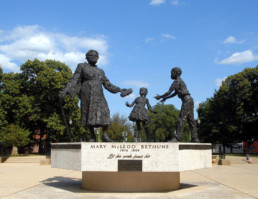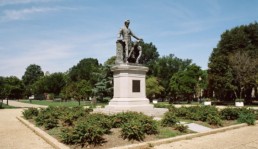Mary McLeod Bethune Memorial
Mary McLeod Bethune Memorial is a bronze statue honoring educator and activist Mary McLeod Bethune, by Robert Berks.
The monument is the first statue erected on public land in Washington, D.C. to honor an African American and a woman. The statue features an elderly Mrs. Bethune handing a copy of her legacy to two young black children. Mrs. Bethune is supporting herself by a cane given to her by President Franklin D. Roosevelt. The statue was unveiled on the anniversary of her 99th birthday, July 10, 1974, before a crowd of over 18,000 people. The funds for the monument were raised by the National Council of Negro Women, the organization Mrs. Bethune founded in 1935.
Emancipation Memorial
The Emancipation Memorial, also known as the Freedman’s Memorial or the Emancipation Group, and sometimes referred to as the "Lincoln Memorial" before the more prominent so-named memorial was built, is a monument in Lincoln Park in the Capitol Hill neighborhood of Washington, D.C.
Designed and sculpted by Thomas Ball and erected in 1876, the monument depicts Abraham Lincoln in his role of the "Great Emancipator" freeing a male African American slave modeled on Archer Alexander. The ex-slave is depicted on one knee, with one fist clenched, shirtless and shackled at the president's feet.
The statue originally faced west towards the U.S. Capitol until it was rotated east in 1974 in order to face the newly-erected Mary McLeod Bethune Memorial.
The monument has long been the subject of controversy. According to information from American University:
If there is one slavery monument whose origins are highly political, the Freedman’s memorial is it. The development process for this memorial started immediately after Abraham Lincoln's assassination and ended, appropriately enough, near the end of Reconstruction in 1876. In many ways, it exemplified and reflected the hopes, dreams, striving, and ultimate failures of reconstruction.
Despite being paid for by African Americans, historian Kirk Savage in 1997 condemned it as "a monument entrenched in and perpetuating racist ideology" because of the supplicant and inferior position of the Black figure.

